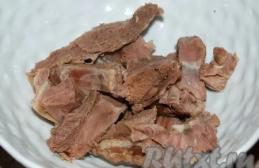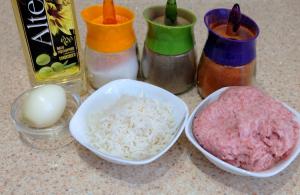Micrococci
The family Mcrococcaceae includes the genera: Micrococcus, Staphylococcus, Sarcina.
Cocci of this family usually have the shape of an almost regular ball. Division coccus in three perpendicular planes leads to the formation of cuboidal clusters (genus Sarcina). Sometimes there are cells connected in pairs.
Majority Microsococeae - aerobes and facultative anaerobes. There are a small number of species classified as obligate anaerobes. Along with saprophytic species, there are pathogenic species (Staphylococcus aureus, etc.), which can cause various pathological processes in the body of humans and animals, as well as cause food poisoning. Saprophytic microorganisms of the Microsoccaceae family are widespread in nature; when they get on food products, they can cause various defects: bitter taste of milk and cheese, thickening of milk, rancid taste of butter, formation of brown spots on cheese, etc.
The genus Micrococcus is a strict aerobe, unlike the genus Staphylococcus. When growing on MPA, they form medium-sized, round, white, yellow or pink colonies. There are also various shades from red to orange, especially common among the saprophytic micrococci M. roseus. M. flavus. The pigments produced by micrococci are insoluble in water. The optimal development temperature is 20 -- 25°C. Many types of micrococci can develop when 5 -- 8°C. In contrast, toxigenic staphylococci are mesophiles. Certain types of micrococci can withstand heating to 63-65 ° C for 30 minutes and short-term pasteurization at high temperatures.
Micrococci are highly resistant to salt and sugar. Some varieties of micrococci (M. radiodurans) are exceptionally resistant to ionizing radiation.
Micrococci are peptonizing microorganisms. When developing in milk, they ferment lactose, increasing the acidity of the milk to 40-45°T, and at the same time secrete rennet; this leads to the formation of a clot in the milk and the appearance of defects in milk and dairy products (premature curdling, thickening of sweetened condensed milk, bitter taste). Some types of micrococci decompose fat and cause the product to taste rancid.
Lactic acid bacteria
Lactic acid bacteria are widespread in nature. Under certain conditions they can cause spoilage of many foods.
Based on morphological characteristics, they are divided into streptococci and rods. Each group contains homo- and heterofermentative bacteria.
Lactic acid streptococci. Lactic acid streptococci belong to the family Streptococcus and the genera Lactococcus and Leuconostoc. Homofermentative include milk (Laс. lacnis) and cream (Lac. cremoris) streptococci. Heterofermentative are aroma-forming streptococci, or citrovoruses, capable of producing aromatic substances (diacetyl, acetoin) and assimilating citric acid salts - citrates. This group includes Lac. diacetylactis, Leu. cremoris, Leu. dextranicum
The thermophilic streptococcus Str. occupies an intermediate position between homo- and heterofermentative streptococci. thermophilus, which is why it is sometimes called a moderately heterogeneous species.
Lactic acid streptococci are spherical or oval cells up to 1--2 microns in diameter, arranged in short chains or in pairs; are motionless, do not form spores or capsules, stain positively on Gram. In young cultures, some strains of creamy streptococcus form a mucous capsule. The cells of aromatic streptococci are somewhat smaller than Lac cells. lactis and Lac. cremoris, and the cells of thermophilic streptococcus are larger than those of creamy streptococcus.
Lactic acid streptococci, like bacilli, are facultative anaerobes in relation to oxygen, that is, they grow not only under anaerobic conditions, but also with access to molecular oxygen. However, in the presence of oxygen, their type of respiration does not change, since aerobic respiration does not occur, but the fermentation process continues.
Therefore, lactic acid bacteria can be classified as aerotolerant (air-tolerant) anaerobes.
The temperature limits of the life activity of these microorganisms are quite wide. For mesophilic species, the optimal temperature is 25-30 °C, but there are also thermophiles that grow at 38-43 °C. The minimum development temperature for mesophilic lactic acid bacteria is 10 ° C, for thermophiles - 20-22 ° C. There is evidence that some lactic acid bacteria are capable of growing at very low temperatures above zero (up to 3 °C).
In terms of nutritional requirements, lactic acid bacteria are among the most complex microorganisms. They can use mono- and disaccharides and organic acids as a carbon source.
They do not develop on ordinary nutrient media, but grow on media with the addition of amino acids, hydrolysates of meat proteins, lactalbumin, casein, and various types of flour. Most types of lactic acid bacteria require amino acids: arginine, cysteine, glutamic acid, leucine, phenylalanine, tryptophan, tyrosine, valine. Only some types of lactic acid streptococci can grow on media containing ammonium salts as the only sources of nitrogen,
Most lactic acid bacteria require vitamins - riboflavin ( AT 2), thiamine (B1), pantothenic (Bz), nicotinic (PP), folic ( Sun) acids, pyridoxine ( AT 6) etc. This explains the positive effect on the growth of microorganisms of additives to nutrient media of various nutritional extracts (corn, carrots, potatoes), yeast autolysate and other vitamin-containing compounds. The growth of lactic acid bacteria is also stimulated by certain peptides, purines (adenine, guanine, hypoxanthine), pyrimidines (uracil, thymine, etc.), fatty acids (acetic, oleic), and citric acid.
Lactic acid bacteria are cultivated in skim sterile milk or in solid and liquid artificial nutrient media using hydrolyzed milk and other nutrients obtained from milk.
When lactic acid streptococci develop in milk, they cause it to coagulate (with the exception of Leu. demons), i.e., the formation of an even, dense clot without abundant whey separation, which has a pleasant sour-milk taste and smell. Flavor-producing streptococci form a clot in which small amounts of carbon dioxide bubbles can be found. On a nutrient medium (agar with hydrolyzed milk and chalk), lactic acid streptococci form small (0.5-1 mm) drop-shaped colonies with a smooth edge, with chalk clearing zones. Colonies in the thickness of the feeding medium (deep colonies) have the shape of a boat or a lentil grain. Lac. diacetilactis on 3% agar; can form deep colonies in the form of spiders or lumps of cotton wool, reminiscent of colonies of lactic acid rods.
Lactic acid bacteria grow in environments with low pH values from 5.5 to 8.8, some at pH 2.9-3.2. A characteristic property of lactic acid bacteria is their high alcohol resistance. They can develop on nutrient media containing 15--18 % ethyl alcohol, less often - at 24%.
The biochemical properties of lactic acid bacteria are studied by the energy of acid formation, limiting acidity, the ability to ferment citric acid salts, the quality of the curd, the possible proteolytic activity of bacteria, etc.
The energy of acid formation is determined by the time of formation of a milk clot (acidity about 58-60 °T) when adding 0.5 cm of a young (12-20 hour) culture to 10 cm 3 of sterile skim milk and growing the crops at the optimal temperature.
The acidity of milk according to Turner is determined by titration with a decinormal solution of sodium hydroxide with phenolphthalein as an indicator. For titration, take 10 cm 3 of milk diluted with 20 cm 3 of water (you can take 2 times less). The volume of alkali (in cm3) used to neutralize the acid is multiplied by 10 (20) and thus the acidity of the milk is obtained (1 °T corresponds to 9 mg of lactic acid in 100 cm3 of milk).
The proteolytic activity of bacteria is studied on meat-peptone gelatin, milk, or determined using special biochemical studies and judged by the total amount of water-soluble protein breakdown products formed, the formation of ammonia, hydrogen sulfide, indole, which characterize the deep breakdown of protein substances.
The ability to ferment citric acid salts (citrates) is determined by inoculating bacteria on a solid medium with calcium citrate. The appearance of clearing zones around the colonies indicates the formation of water-soluble fermentation products in the presence of the enzyme citritase.
Activity the formation of aromatic substances is determined by the amount of volatile compounds formed (by sublimation method) and four-carbon compounds (diacetyl and acetoin).
Lactic acid streptococci have different enzymatic activities.
Lac. lactis is an active acid-former. Active strains curdle milk in 4-7 hours. The maximum acidity during its development reaches 120 °T. Restores and coagulates litmus milk, does not form acetoin, decomposes arginine to form ammonia. Does not develop in an environment containing 6.5 % NaSi, and in an alkaline environment at pH 9.5. Many strains produce the antibiotic nisin, which is a polypeptide with a molecular weight of 3500. It suppresses most streptococci (but not enterococci), staphylococci, micrococci, some types of bacilli, lactobacilli, clostridia, and actinomycetes. However, nisin does not have a bactericidal effect against gram-negative bacteria.
Lac. cremoris, unlike milk streptococcus, does not ferment maltose and dextrin, and lacks the ability to deaminate arginine. Does not grow on media containing 4 % KaS1, as well as at a temperature of 39-40 °C. At low cultivation temperatures (15-20 °C), some strains form a significant amount of volatile acids, reduce and curdle (sometimes only partially) litmus milk. There are mucus-forming strains that form milk clots. They are used in starter cultures for the production of sour cream.
Energy of acid formation in Lac. cremoris is weaker than Lac. lactis, and is 6-8 hours, and the maximum acidity is 110-115°T.
Aroma-forming streptococci contain the enzyme citritase, which breaks down citrates to form carbon dioxide (CCb) and aromatic substances - acetoin and diacetyl. A relatively weak acid former, but it forms diacetyl in significant quantities. It has low acid formation energy (more than 16 hours), the maximum acidity in milk reaches 70-100 °T. The milk curd often contains gas bubbles (CO2). The smell of the clot is specific, due to the accumulation of diacetyl. Restores and curdles litmus milk, first it turns pink, then quickly discolors. Many strains decompose arginine with the release of ammonia and are resistant to being kept in the environment 4 % NaCl. Leu. dextranicum is also a weak acid former. It coagulates milk at the optimal temperature after 2-3 days. The maximum acidity is 70 - 80 °T. For the development of Leu. dextranicum and Leu. cremoris, manganese is of great importance, the addition of which to milk stimulates their growth and flavor formation.
Str. thermophilus surpasses all lactic acid streptococci in the energy of acid formation, reaching the level of thermophilic lactobacilli. It ferments milk in 3.5 - 6 hours, the maximum acidity is 1 10 - 1 15 ° T.
Streptococcus thermophilus does not grow on media containing penicillin 0.01 IU/cm 3 and streptomycin 5 μg/cm 3 used as a test culture for detecting antibiotics in milk. Sensitive to the action of specific bacteriophages. More intensive growth of thermophilic streptococci is observed when basic amino acids - valine, leucine, isoleucine, lysine, arginine, methionine, histidine and proline - are added to the nutrient media. Str. thermophilus has relatively high heat resistance. It can withstand temperatures of 75 °C for 15 minutes and 65 °C for 30 minutes, as a result of which it constitutes a significant part of the residual microflora in milk after pasteurization.
In a liquid medium containing glucose and 4% NaCl, thermophilic streptococcus does not form acid, but at a content of 2 % MaCl lactic acid is synthesized by individual strains. If present in the environment 0.1 % methylene blue Str. thermophilus does not develop, it does not reduce litmus milk. Some strains form diacetyl and synthesize acetoin in small quantities.
Lactic acid sticks. Lactic acid bacilli (lactobacteria) belong to the Lactobacteriaceae family, the genus Lactobacterium, which includes three subgenera: Thermobacterium, Streptobacterium and Betabacterium. Thermo- and streptobacteria are homofermentative, and beta-bacteria are heterofermentative lactic acid rods.
To thermobacteria There are 8 types of sticks, among which the most commonly used are L. helveticum, L. acidophilum, L. bulgaricum, L.lactis. The streptobacter subgenus includes 7 species, among which L. plantarum and L. rhamnosus are used in the dairy industry. The subgenus of beta bacteria includes 11 species of rods, the most studied among them are L. brevis, L. buchneri, L. fermentum, etc.
Lactobacilli They are rods, single or connected in pairs, with dimensions of (4...10) x (0.5...0.6) microns. They are immobile, do not form spores or capsules, and have a positive Gram stain. Streptobacter cells are smaller than thermobacter cells and are often arranged in chains. Beta bacteria have the smallest and thinnest cells.
Lactic acid rods are facultative anaerobes or microaerophiles. In relation to temperature, streptobacteria and beta bacteria are mesophiles, thermobacteria are thermophiles. They do not grow on regular media; they are grown on media with milk. When developed in milk, they cause the formation of a homogeneous dense clot with a pleasant sour milk smell and taste.
On a dense nutrient medium, lactobacilli form small, smooth, shiny colonies with a spherical gray-white surface. Colonies of lactobacilli of different species are almost the same. However, in some cases, fibrous R-form colonies growing into the substrate are observed, in contrast to smooth S-form colonies. Deep colonies of thermobacteria can be dark, yellowish-brown, sometimes with short extending filaments. Unlike deep colonies, surface colonies are larger, curl-like or granular. Deep colonies of streptobacteria are boat-shaped, sometimes with outgrowths.
Temperature growth limits for thermobacteria are 20 - 55 °C, for mesophiles -- 15-38 °C. The optimal development temperature for L. helveticum is 40 °C, for L. bulgaricum, L. lactis - 45 °C, L. acidophilum - 37-38 °C. For mesophiles, the optimal temperature is 30 °C.
Lactobacilli have weak proteolytic activity and therefore do not grow in substrates where the only source of nitrogen is protein, i.e., where various amino acids are absent.
At the same time, there are lactic acid bacteria that can break down proteins.
Lactic acid bacteria do not reduce nitrates to nitrites and do not form pigments. Cytochromes and peroxidase do not form, but some produce catalase, which decomposes hydrogen peroxide (H2 O2). Lactobacilli have pronounced saccharolytic properties. In addition to glucose and lactose, they also ferment other sugars. Thus, many homo- and heterofermentative species (L. plantarum and L. brevis, etc.) intensively use pentoses, sometimes even more actively than glucose.
Heterofermentative lactic acid bacteria ferment fructose because they have mannitol dehydrogenase, which reduces fructose to mannitol. The products of fermentation of fructose are also lactates, acetates and carbon dioxide.
Thermophilic lactic acid rods are active acid formers, they ferment milk in 4-5 hours, the maximum acidity reaches 200-350° T,
L. helveticum is the most active acid-former; the maximum acidity of milk during its development reaches 350 °T. This stick ferments maltose and dextrin, but does not ferment sucrose, raffinose, or salicin. Some strains develop in substrates containing up to 5% table salt.
Strains of L. helveticum can be isolated from calf abomasum or sour raw milk.
L. bulgaricum brings the maximum acidity of milk to 200-300°T. Strains of Bulgarian bacillus produce acetaldehyde, an aromatic substance that imparts a specific taste and smell, and antibiotic substances that suppress unwanted intestinal microflora. Bulgarian bacillus is sensitive to many antibiotics and resistant to bacteriophage.
Strains of L. bulgaricum are usually isolated from raw milk. L. acidophylum is an intestinal microbe that can be isolated from the contents of the digestive tract of humans and various animals. Acidophilus bacillus is capable of re-establishing itself in the human intestine after cultivation in milk and suppressing the development of pathogenic and undesirable microorganisms there (Salmonella, Shigella, Staphylococcus, Escherichia, etc.). The antagonistic effect of L. acidophylum is due to the antibiotics produced - acidophilin and lactocidin.
Acidophilus bacteria are resistant to alkaline reaction (pH 8.3), the presence of phenol in the medium (0.25-0.4%), bile (20 %), KaCl (2%). The maximum acidity of acidophilus bacillus reaches 200-250 °T. L. acidophylum ferments sucrose, maltose, salicin, often raffinose, and dextrin. There are mucus-forming strains of acidophilus bacillus.
L. lactis in its properties and behavior in sourdough is very similar to L.bulgaricum. They ferment glucose, lactose, maltose, sucrose, galactose, raffinose, dextrin and salicin. The maximum acidity of milk fermented with L. lactis reaches 120-180 °T.
As a result of the vital activity of heat-resistant sticks, intense acid formation occurs, which causes a defect in cottage cheese, sour cream, and ordinary yogurt - an excessively acidic taste. May cause stringiness and an unclean, unpleasant taste.
Streptobacteria have a less pronounced acid-forming ability. They ferment milk after 2-3 days, the maximum acidity is 180 °T.
Streptobacteria L. plantarum and L. rhamnosus are capable of assimilating, in addition to lactose, also lactic acid salts, i.e. lactates. They grow in hydrolyzed milk containing 6% NaCl and 20-40% bile, reduce and curdle litmus milk and do not form ammonia from arginine. They have high proteolytic activity (2 times higher than that of mesophilic lactic acid streptococci), the content of free amino acids in milk increases from 10 to 60 mg%. L. rhamnosum, unlike L. plantarum, forms CO2 of sodium citrate.
L. plantarum produces the antibiotic lactolin, which has a depressant effect on intestinal microflora and butyric acid bacteria.
Streptobacteria have pronounced saccharolytic properties. They ferment fructose, galactose, mannitol, mannose, raffinose, ribose, salicin, sorbitol, trehalose, esculin, etc. Glucose is fermented without the formation of gas.
Milk is an amazing invention of nature. Man has long appreciated the nutritional and medicinal properties of milk and not only learned to use this product, but also significantly improved it.
Various food products began to be produced from milk. For example: yogurt, kefir, yogurt, sour cream, cottage cheese, butter. Over time, many questions have arisen about the qualitative composition of milk and its effect on the body.
Milk contains more than 200 substances that are easily accessible to microorganisms, so they multiply intensively in it. Milk contains proteins, peptones, polypeptides, globulins, albumins, casein, and amino acids. Milk contains fatty acids, lipids, milk sugar (lactose), vitamins, hormones, enzymes and mineral salts. And there are always microorganisms in natural milk, since the udder is an open organ.
Milk, even when received under good sanitary conditions, is not a sterile product. In practice, it is sterile only in the udder of the animal. Already at the moment of milking, milk is subject to bacterial contamination, since saprophytic bacteria are constantly present in the nipple canal and mammary gland. The first streams of milk are especially contaminated, and the last portions are mostly sterile.
The first person to see the microflora of fermented milk products was the Frenchman Louis Pasteur. These studies have generated great interest in this topic. Through the efforts of microbiological scientists, both the physiology of the microorganisms themselves and the biochemical processes of fermentation and putrefaction caused by bacteria were studied. And this is exactly what will be discussed further.
Causes of pathogenic microflora in milk
The number of bacteria in milk obtained from healthy cows is insignificant - from 1000 to 10,000 per ml. These are mainly saprophytes - non-pathogenic micrococci, coryne bacteria, penetrating from the outside through the nipple. If the sanitary rules of milking are violated, many microorganisms from the environment get into the milk: from dirty hands, from water, dust, etc. In addition to ordinary E. coli, pathogenic microorganisms (dysentery microbes, salmonella, cholera vibrios, etc.) may be present.
Putrefactive bacteria, butyric acid bacteria, proteus and many others are accidentally found in milk. Sources of milk microflora, in addition to the udder parenchyma, are: milk containers, pipelines, udder skin, milker's hands, feed, air in livestock buildings. The largest number of microbial bodies is located in the teat canal of the udder. This is facilitated by the presence of milk, the openness of the channel for microorganisms and positive temperature. Microbes in the nipple canal form a so-called bacterial plug. Before milking with the first streams of milk, the bacterial plug is removed into a separate vessel and disinfected.
Lactating animals with infectious diseases excrete pathogens in their milk (anthrax, tuberculosis, brucellosis, Q fever, etc.). In milk at a certain temperature, normal, abnormal and pathogenic microflora can multiply. Therefore, to preserve the quality of milk immediately after receiving it, it is immediately cooled to a temperature of +10-12oC.
During long-term storage of raw milk (at temperatures above 10°C), not only their quantitative growth occurs, but also a change in the phases of the microflora of fresh milk. The bacterial phase is a period of time during which the microbes present in it do not multiply due to milk substances (lysozyme, immunoglobulins, lactoferrin) that have a depressing effect on microbial bodies. The duration of the bacterial phase depends on the urgency of cooling the milk and is inversely related to the number of microbes in the milk, its temperature and can last up to 24 – 48 hours.
Phases of change in the microflora of fresh milk
The first phase is bactericidal, when the vital activity of microorganisms in milk is suppressed. Microbes in this phase, as a rule, do not multiply, sometimes their number even decreases as a result of the bactericidal effect of lactein I and II, lysozyme and leukocytes. The duration of the bactericidal phase depends on the number of bacteria present in the milk, storage temperature and the individual properties of the animal’s body. The duration of the bactericidal phase is of great importance, since milk is considered more reliable only during this phase, and after it ends, microorganisms begin to develop and the milk spoils faster.
The temperature of milk storage has a great influence on the duration of the bactericidal phase. So, at a temperature of 37°C it is only 2 hours; at 10°C - up to 36 hours, at 5°C - up to 48 hours, and at 0°C - up to 72 hours. With an increase in the number of microbes in milk by several thousand per ml at the same storage temperature, the duration of the bactericidal phase is reduced by approximately 2 times. According to GOST, the cooling temperature for prepared milk should not be higher than 10°C. However, at this temperature, milk is stored only for 24-36 hours. The most effective temperature is 3-4°C. The duration of the bactericidal phase is also influenced by the sanitary conditions of milk production. Milk obtained in strict compliance with sanitary and anti-epidemic rules retains its bactericidal properties longer.
The second phase - the phase of mixed microflora - is characterized by the most active proliferation of microorganisms. In 1-2 days, the number of bacteria in 1 ml of milk can increase from several thousand to hundreds of millions. The rate of development of microbes depends on their initial quantity and the storage temperature of the milk. In this phase, cryoflora (or flora of low temperatures), mesoflora (medium temperatures), thermoflora (high temperatures) are distinguished.
At low temperatures, milk can remain in the phase of mixed microflora (cryoflora) for a long time. However, at a temperature of about 0°C during long-term storage, the number of bacteria increases noticeably and after a few days can reach tens and hundreds of millions per 1 ml.
Mesoflora in milk develops during its storage without pre-cooling. It is characterized by the rapid development of microorganisms and an increase in the number of lactic acid bacteria. Therefore, milk should be stored and transported only in the cryoflora phase. Thermoflora is present at a milk temperature of 40-45°C, for example, during the production of cheeses with a high second heating temperature. In this case, thermophilic lactic acid bacilli and thermophilic streptococci develop.
The third phase is the phase of lactic acid bacteria. During this period, the increasing concentration of lactic acid (65-70°T) leads to the gradual death of lactic acid streptococci, which are replaced by lactic acid rods.
The fourth phase is the yeast and mold phase. These microorganisms are resistant to acid reaction and use lactic acid for metabolism. As a result of a decrease in acidity, favorable conditions are created for the development of putrefactive bacteria, which decompose the protein substances of milk into volatile and gaseous products. At a milk storage temperature of 10-12°C, the number of bacteria increases 10 times during the day, at 18-20°C - hundreds of times, at 30-35°C - tens and hundreds of thousands of times. Because of them, milk stored at low temperatures goes rancid and becomes unsuitable for food, as well as for feeding to young animals. To disinfect and preserve milk, pasteurization, boiling, drying, ultrasound and the phenomenon of cavitation are used. The sanitary quality of milk is assessed by its acidity, expressed in degrees, the number of microorganisms in 1 ml of milk, coli titer and the presence of infectious agents.
Thus, to maintain the quality of milk, the following conditions must be observed: immediately cool the milk on the farm to the recommended temperatures, send it as soon as possible in isothermal tanks for processing to dairies, create appropriate conditions for storing milk at the plant, heat treat the milk followed by cooling and immediate shipment for sale or production of dairy products.
Brief information about fermented milk products
There are many mysteries associated with kefir, a widespread drink. For example, there is no consensus on the origin of kefir grains.
Kefir grains are a complex symbiosis (coexistence) of microorganisms formed during a long process of development. Aged microorganisms behave like a whole organism. They grow together, reproduce and pass on their structure and properties to subsequent generations.
White or slightly yellowish kefir grains have a specific sour taste. Their main microflora consists of lactic acid bacilli, streptococci and yeast. They determine the specific taste and aroma of kefir, its nutritional properties.
During the life of the kefir grain, the microorganisms that make up its composition cause changes in the milk. Under the influence of lactic acid streptococci and rods, lactic fermentation occurs, yeast causes alcoholic fermentation.
Thanks to these processes, the constituent elements of milk undergo changes, especially milk sugar. The resulting carbon dioxide and alcohol activate the activity of the stomach, accelerate the digestion process, and stimulate the appetite. Lactic acid has a beneficial effect on the intestinal microflora and delays the development of putrefactive bacteria.
To make sour cream you need cream. In this case, pure bacterial cultures are used, which include lactic acid and creamy streptococci and aroma-forming bacteria.
Cottage cheese is a favorable environment for the development of microorganisms that can cause its spoilage. Cottage cheese is fermented with pure cultures of lactic acid streptococci and flavor-forming bacteria. Sourdough usually has a sour milk taste, without any odors, gas formation, or protruding whey.
In yogurt, a variety of lactic acid bacteria, Bulgarian bacillus, discovered by I.I. Mechnikov, is used as a starter. When preparing yogurt, the starter consists of pure cultures of thermophilic streptococcus and Bulgarian bacillus, contained in equal proportions. If this ratio is violated, the product may acquire a sharply sour taste, a grainy structure, or quickly release whey.
Like any fermented milk product, yogurt is certainly healthy (especially with dietary supplements), but live bacteria remain in it, as a rule, for no more than one to two weeks. Yogurts with a long shelf life are most often a sterile dairy dessert, with or without fruit.
Yogurt is characterized positively if it has a pleasant fermented milk taste and aroma, a homogeneous structure and a fairly dense consistency.
Yogurt quickly relieves hunger, like most fermented milk products, it is useful for people of all ages.
Human use of lactic acid products
It has been proven that the use of lactic acid products accelerates the elimination of various radionuclides. A real fermented milk product necessarily contains live microorganisms (lactic acid bacteria), which make up the bulk of the microflora of the human digestive tract. An imbalance of microflora, called dysbiosis, can lead to all sorts of diseases: gastric and duodenal ulcers, allergies, gastritis. One of the most unpleasant consequences of dysbacteriosis is a decrease in the body’s immune functions; it entails protracted treatment of diseases and the development of complications. Due to impaired digestive functions, fatigue increases, fatigue and lethargy appear.
Dysbacteriosis is common in both adults and children. The cause of their occurrence may be stress, unfavorable environmental conditions, poor-quality drinking water and food. The intestinal microflora is also disrupted after taking antibiotics, which kill bacteria necessary for the body.
Dysbiosis has to be treated with medications, but fermented milk products, primarily kefir and biokefir and bifidok prepared on its basis, help prevent it. These drinks, equivalent in composition, are improved kefir with the addition of bifidobacteria - microorganisms characteristic of humans that help the digestion process (they account for, for example, about 90% of the microflora of the large intestine).
The Japanese use kefir to prevent the treatment of ancogynesis of the stomach and intestines. Lactic acid products “healthy” the intestinal microflora and treat gastritis. To treat gastritis with high acidity, fresh (one-day old) kefir (contains traces of alcohol) is used; with low acidity, three-day old kefir is used.
Also, lactic acid bacteria suppress the development of putrefactive bacteria that cause colitis: Shigella, which causes dysentery, and Salmanella, which causes typhoid fever. Fermented milk products are included in the diet of any person. Depending on the combination of genera and species of lactic acid bacteria, various fermented milk products are obtained from them.
Milk has damaging properties. With the first drops of breast milk, a mother (sow, cow, etc.) gives everything to her child (pig, calf). The composition of milk is staggering with a long list of beneficial microorganisms, but if anti-epidemic and sanitary standards are not observed, milk can not only provide many useful substances, but also seriously undermine the health of its consumer. To prevent this from happening, you need to be extremely careful and treat the process of milking and further processing of dairy products with trepidation.
Department of Microbiology, Virology and Pharmacology
Microbiology course
080401 “Commodity research and examination of food products”
Essay
Discipline: Microbiology of food products
On the topic: Microbiology of milk
Milk is the secretion of the mammary glands of mammals, physiologically intended for feeding young animals. Milk is formed from the constituents of blood by the epithelial cells of the alveoli and is a valuable food product. It contains fatty acids, amino acids, proteins, minerals, vitamins, milk sugar and a large number of enzymes. The nutrients in milk are in the ratio and form most favorable for absorption by the body. Freshly milked, fresh milk is the most complete. It has bactericidal properties, i.e. the ability to inhibit the proliferation of bacteria entering milk and even kill them. To preserve the bactericidal properties of fresh milk, it is cooled. At a temperature of 30 o C, bactericidal activity persists for 3 hours, at 15 o C - about 8 hours, at 10 o C - about 24 hours.
Microbes enter milk from the external environment through the excretory ducts, milk tank and nipple canal. For some of them, milk serves as a good nutrient medium.
Most microbes are found in the nipple canal and milk cistern and fewer in the excretory ducts and alveoli. Some microbes die under the influence of cidical substances; more persistent micrococci and streptococci, which in their properties are close to lactic acid streptococci of intestinal origin, remain. Microbes accumulate near the nipple canal and form a plug, which, along with saprophytes, can contain pathogens of infectious diseases. Usually there are more of them in the first portions of milk and less in the last. Therefore, the first portions of milk must be milked in separate containers to prevent contamination of the entire milk and the environment. The contamination of milk with microbes depends on the cleanliness and condition of the udder, the skin of the animal, human hands, dishes and other equipment.
There are especially many different microbes in the milk of animals with mastitis. One of the reasons may be microbes that penetrate the mammary gland through the nipple canal or hematogenously. Contributing factors include hypothermia, injury, and genetic predisposition. Inflammatory products reduce the quality of milk, and the amount of lactose, calcium, and casein decreases. Staphylococci, streptococci, E. coli and other microorganisms can be found in mastitis milk. Their numbers are largely determined by the state of the external environment.
Microbes are found in large numbers on the surface of the animal's skin. The dirtier the skin, the more of them get into the milk. Thus, according to Backhaus and Conheim, in 1 ml of milk from a cow with unclean skin there are from 170 thousand to 2 million microbes, in a cow with clean skin - 20 thousand. With systematic cleaning of the animal, their number decreases to 3 thousand in the same volume. Microbes come to the surface of the skin from food, bedding, manure, and air.
Another source of milk contamination can be feed: when distributing it, a lot of dust is generated. Along with dust, microbes also get into the milk. Therefore, you should not distribute feed during milking. If old rotted straw is used as bedding, it may contain a large number of microorganisms, especially mold fungi. Scattering such bedding before milking increases the number of microbes and their spores both in the air, on the surface of the animal’s body, and in the milk. In this regard, it is better to use fresh straw, sawdust, shavings, dry leaves or peat as bedding, which absorb moisture, gases and to some extent prevent the development of putrefactive and pathogenic microorganisms. According to A.K. Skorokhodko, E. coli, salmonella, and typhoid bacteria in peat litter die within 6-8 days.
A person can also be a source of contamination of milk with microbes if personal hygiene rules are not followed. Therefore, the hands of the milkmaid (milker) should be clean, dry, with short-cut nails.
Microorganisms can get into milk and through the air from animals suffering from tuberculosis, salmonellosis, etc.
The role of flies in the contamination of milk with microbes is enormous. The surface of their body contains from several thousand to a million microbes, some of which may be pathogenic. To combat flies, farms, milk collection points and the surrounding area are thoroughly cleaned, washed, whitewashed, and disinfected. It is better to clean the premises using a wet method, which significantly reduces the number of microbes and, consequently, reduces the contamination of milk.
Dishes and milking equipment can also be sources of milk contamination. Therefore, milking machines, utensils used, and filters must be kept clean. When milking by machine, milk enters a closed system, which prevents microbes from entering it from the outside. However, poor organization of machine milking leads to a deterioration in the sanitary condition of milk. In this case, the number of microbes increases by 4-5 times, and sometimes more, compared to manual milking. Indicators of the sanitary quality of milk are reflected in the following table:
Sanitary quality of milk when cows are kept in stalls (according to E.Sh. Akopyan)
The table data shows that the quality of milk during manual milking turned out to be higher than during machine milking. All of the above sources of milk contamination can be minimized or eliminated by observing zoohygienic and other rules in the areas where dairy animals are located and in the process of obtaining the product.
Another type of milk contamination should be noted, which is associated with a new species of Bacillus, identified by experts of the International Dairy Federation (IDF) and named Bacillussporothermodurans (Peterson et al., 1996). Bacillussporothermodurans can be isolated from UHT and sterilized whole and skim milk, UHT cream, chocolate milk, condensed and reconstituted milk. These heat-stable spore formers do not alter the stability or sensory characteristics of UHT milk. In all cases where contamination with these bacteria was detected after incubation, the total amount in milk cartons never exceeded a maximum of -150/ml. However, sometimes when such contaminated milk is boiled, curdling occurs. The curdling and pinkish color are due to the long shelf life of milk bottled in plastic bottles. Such packaging is a poor oxygen barrier compared to cardboard ones. Bacterial growth is possible in milk packaged in different packaging materials: polyethylene, cardboard, Terta-Brick and aluminum.
Contamination of UHT and sterilized dairy products by Bacillus sporothermodurans is apparently not a result of secondary contamination, but due to the survival of spores during the cooking process (Hammer et al., 1995). Various sources of pollution can be considered.
The first possible source of Bacillussporothermodurans is raw milk contaminated on the farm. In 1955, Bacillussporothermodurans were first discovered in raw milk supplied from a farm. In 1966, 100 raw milk samples taken from six different geographic regions were analyzed. A PCR (polymerase chain reaction) based method was used to detect Bacillussporothemiodurans. Three samples from the same region tested positive at 100 ml. These results suggest the occasional or local presence and/or very low level of contamination of raw milk with Bacillus sporothermodurans spores. Spores were found in only 2 of 120 samples of corn silage, grass silage and sugar beet. Therefore, contamination of raw milk on farm through feed and milking equipment is most likely but not yet proven.
Reprocessing of contaminated batches of UHT or sterilized dairy products may be considered a second possible route of Bacillussporothermodurans contamination. Since spores can remain viable after heat treatment, one contaminated package containing 103 spores/ml can lead to contamination of a significant portion of UHT milk during subsequent production.
The third route of contamination is possible during the processing of contaminated milk powder. Hammer et al, (1995) reported the isolation of Bacillussporothermodurans in milk powder used for processing.
As you can see, there are many sources of milk contamination by microbes, the composition and number of which vary depending on the storage time of the product. In this case, several phases are distinguished.
Antimicrobial (cidal, static) phase characteristic of freshly milked milk, it exhibits a delay in the growth of microorganisms. Sometimes this phase is called bactericidal, which is not true. According to a number of authors, antimicrobial substances in milk have a static effect, inhibit the growth of microbes and do not destroy their cells (I. I. Arkhangelsky, P. A. Obukhov). According to other authors, a cidial effect of microbes is noted (A.F. Voitkevich, S.A. Korolev, V.I. Mutovin), and therefore it is more correct to call this phase antimicrobial, which reflects the essence of the issue.
The antimicrobial properties of milk are associated with y- and p-globulins and are determined by the content of lysozymes, lactenins, bacteriolysins, antitoxins, agglutinins and other substances that come from the blood or are synthesized by the mammary gland. V.I. Mutovin explains the antimicrobial properties of milk by the presence in it lysozyme M, and in the udder - lysozyme B. Lysozyme M has a wide spectrum of action: it inhibits the growth of both saprophytes and pathogenic microbes. At the end of lactation it is inactivated. Although Lysozyme B has a narrower spectrum, its effect is manifested throughout lactation.
For processing and preserving food and drinks. Traditionally, lactic acid bacteria are classified as nonmotile, non-spore-forming coccoid or rod-shaped representatives of the order Lactobacillales(For example, Lactococcus lactis or Lactobacillus acidophilus). This group includes bacteria that are used in the fermentation of dairy products and vegetables. Lactic acid bacteria play an important role in the preparation of dough, cocoa and silage. Despite their close relationship, pathogenic representatives of the order Lactobacillales(for example, pneumococci Streptococcus pneumoniae) are usually excluded from the group of lactic acid bacteria.
On the other hand, distant relatives Lactobacillales from the class of actinobacteria - bifidobacteria are often considered in the same group with lactic acid bacteria. Some representatives of aerobic spore-forming genera Bacillus(For example, Bacillus coagulans) And Sporolactobacillus(For example, Sporolactobacillus inulinus) are sometimes included in the group of lactic acid bacteria due to similarities in carbohydrate metabolism and their role in the food industry.
In nature, lactic acid bacteria are found on the surface of plants (for example, on leaves, fruits, vegetables, grains), in milk, external and internal epithelial integuments of humans, animals, birds, fish. Thus, in addition to their role in food and feed production, lactic acid bacteria play an important role in wildlife, agriculture and normal human life. The impact of accelerated industrialization of lactic acid bacteria production, based on a small number of plant-adapted strains, on the natural diversity of these bacteria and human health remains unexplored.
Kinds
- One of the most common types of lactic acid bacteria is Lactococcus lactis. These are nonmotile cocci that do not form spores, stain well with aniline dyes and Gram stains, and when young they have the form of streptococcus. On meat-peptone agar they give dotted round colonies, in the thickness of the agar - lenticular ones. L. lactis breaks down sugar into two molecules of lactic acid without producing gases. The most favorable temperature for development is +30-35 °C.
Lactococcus lactic acid is constantly found in spontaneously sour milk. When exposed to this bacterium, milk usually curdles within the first 24 hours. When the lactic acid content reaches 6-7 g per liter, sugar fermentation stops, since higher acidity has a detrimental effect on lactic acid lactococcus.
- Lactobacillus bulgaricus - Bulgarian bacillus. The bacterium is named so because it was once isolated from the Bulgarian sour milk “yagurta”. A non-sporeless, non-motile bacterium, reaching 20 in length and often connected in short chains.
It is thermophilic and grows best at temperatures above 40 °C. Milk curdles quickly, and the lactic acid content in it reaches 32 g/l, which is five times more than when infected with lactic acid streptococcus.
Links
Wikimedia Foundation. 2010.
See what “Lactic acid bacteria” are in other dictionaries:
See lactic acid bacteria. (Source: “Microbiology: Dictionary of Terms”, Firsov N.N., M: Bustard, 2006) lactic acid bacteria See Lactobacilli (Source: “Dictionary of Microbiology Terms”) ... Dictionary of microbiology
LACTIC ACID BACTERIA- LACTIC ACID BACTERIA, microbes that cause lactic acid fermentation in milk (resp. dairy products), expressed in the fermentation of milk sugar into lactic acid; Due to the formation of coagulation, milk coagulation occurs. To M. b. relate… … Great Medical Encyclopedia
Big Encyclopedic Dictionary
Pathogens of lactic acid fermentation. Facultative anaerobes, non-spore gram-positive rods and cocci. They use carbohydrates as a source of energy, which are fermented into milk. They develop only on complex nutrition. Wednesdays... ...
A group of bacteria that ferment carbohydrates producing mainly lactic acid. Most are immobile, do not form spores, and are facultative anaerobes. Lactic acid bacteria include lactobacilli, lactic acid streptococcus, etc. They live... ... encyclopedic Dictionary
- (Lactobacterium) a group of anaerobic bacteria that ferment carbohydrates producing mainly lactic acid. All M. b. nonspore-bearing, immobile, gram-positive. There are spherical M. b., the cells of which form chains, for example... ... Great Soviet Encyclopedia
A group of bacteria that ferment carbohydrates to form hl. arr. lactic acid. Most are immobile, do not form spores, and are facultative anaerobes. M. 6. includes lactobacilli, lactic acid streptococcus, etc. They live on plants, in the intestines... ... Natural science. encyclopedic Dictionary
LACTIC ACID BACTERIA- lactic acid bacteria, a group of anaerobic bacteria characterized by the ability to ferment sugars to form lactic acid. There are homofermentative M. b. (for example, Streptococcus lactis, Str. thermophilus), forming when... ... Veterinary encyclopedic dictionary
- (from the Greek bakterion rod), microorganisms with a prokaryotic type of cell structure. Traditionally, Bacteria proper refers to unicellular rods and cocci, or those united in organized groups, immobile or with flagella, contrasting... ... Biological encyclopedic dictionary
Bacteria of the genera Lactobacillus, Streptococcus, etc., when fermenting carbohydrates, form lactic acid. Facultative anaerobes, gram-positive rods and cocci, do not form spores. They grow only on complex nutrient media. Auxotrophs by... ... Dictionary of microbiology
As a rule, we associate the word “bacteria” with various diseases and other troubles. However, this is not quite true. After all, our body is a habitat for a wide variety of microorganisms. Among them there are even bacteria, without which normal life activity is impossible. This group includes lactic acid bacteria that live in the intestines of a healthy person. In general, they are a group of gram-positive microaerophilic microorganisms that promote the fermentation of carbohydrates, thereby producing lactic acid. Such fermentation is often used both in the industrial production of products for the preservation and processing of drinks and food, and at home.
Bacteria perform many beneficial functions in the body. First of all, lactic acid bacteria maintain an optimal balance of acidity in the intestines thanks to their ability to produce acetic and lactic acid.
In addition, they help normalize the protective function of the intestines, which helps a person cope with various and other microorganisms. Lactic acid bacteria have a beneficial effect on the liver by suppressing the increased activity of metabolites.
In addition to acetic acid, these beneficial microorganisms are capable of producing volatile compounds such as hydrogen sulfide and hydrogen peroxide, which effectively suppress various intestinal infections.
Many studies have proven that acid-resistant bacteria, which include lactic acid microorganisms, produce many trace elements and vitamins that contribute to the health of the body as a whole. When interacting with other substances and among themselves, they secrete enzymes necessary for normal metabolic processes and digestion, as well as better absorption of nutrients.
Of particular interest among the entire diversity of lactic acid bacteria are microorganisms of the Lactobacillaccae family and the Slreptocuccaccae family. The latter are widely used in the production of various fermented milk products: sour cream, yogurt with fruit fillings, and cottage cheese. Lactic acid bacteria such as acidophilus bacillus easily take root on the intestinal walls and prevent the division of putrefactive bacteria for human health.
In order for your body to independently maintain the necessary conditions for the reproduction of these microorganisms, no special effort is required. It is enough to stick to a healthy diet. Unfortunately, the modern world is structured in such a way that it is not easy to fulfill this condition. The whole problem is that, despite good nutrition, not all products from the daily diet meet quality standards.
In addition to poor nutrition, the intestinal microflora is adversely affected by such factors as constant stress, alcohol abuse and smoking, as well as long-term treatment with antibiotics.
You can restore healthy microflora in the intestines by eating homemade milk, yogurt, sour cream, cottage cheese or kefir. You can use store-bought lactic acid products, but their benefits will be significantly less.
Depending on the type, lactic acid bacteria can have different effects on the immune system. For example, bifidobacteria, unlike lactobacilli, inhibit the immune response. Therefore, before you buy, pay attention to what kind of lactic acid bacteria they contain in their composition.
Using lactic acid microorganisms, many medicines are produced that are prescribed for disorders of the digestive system such as dysbacteriosis, diarrhea and others.









